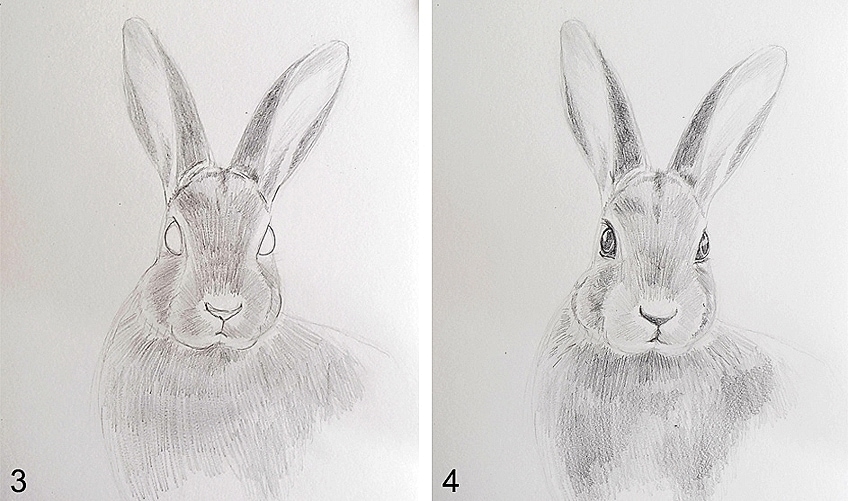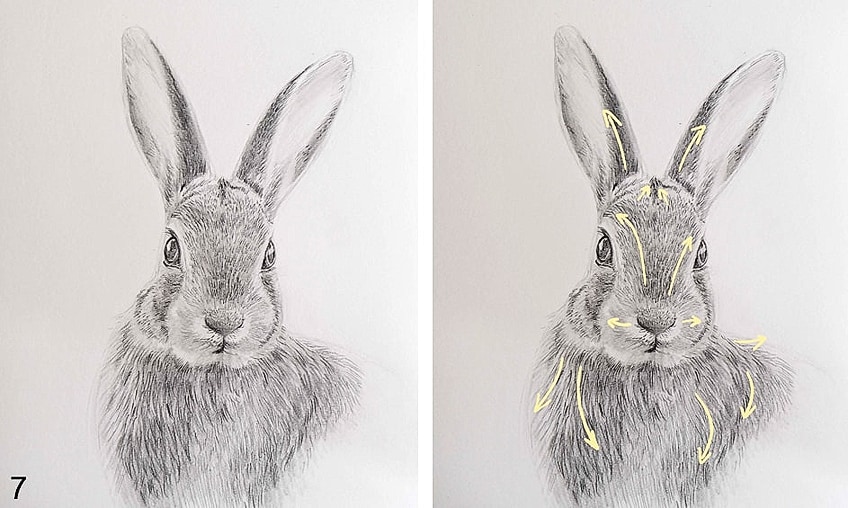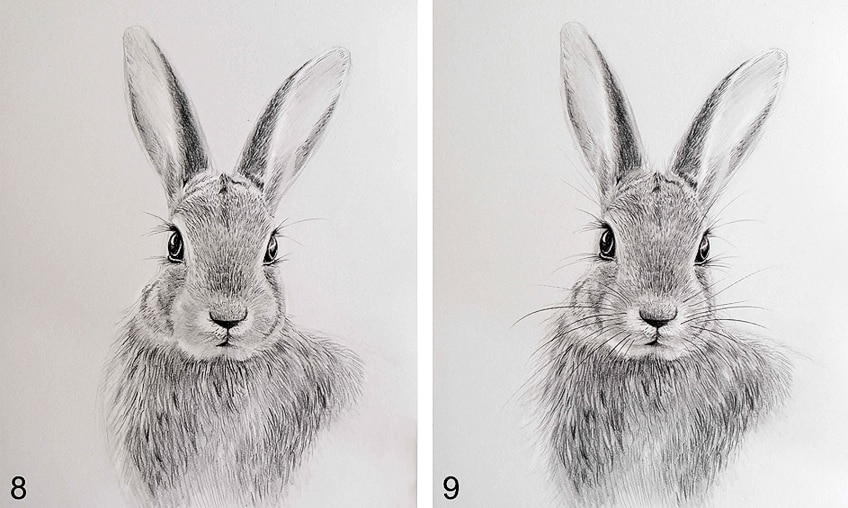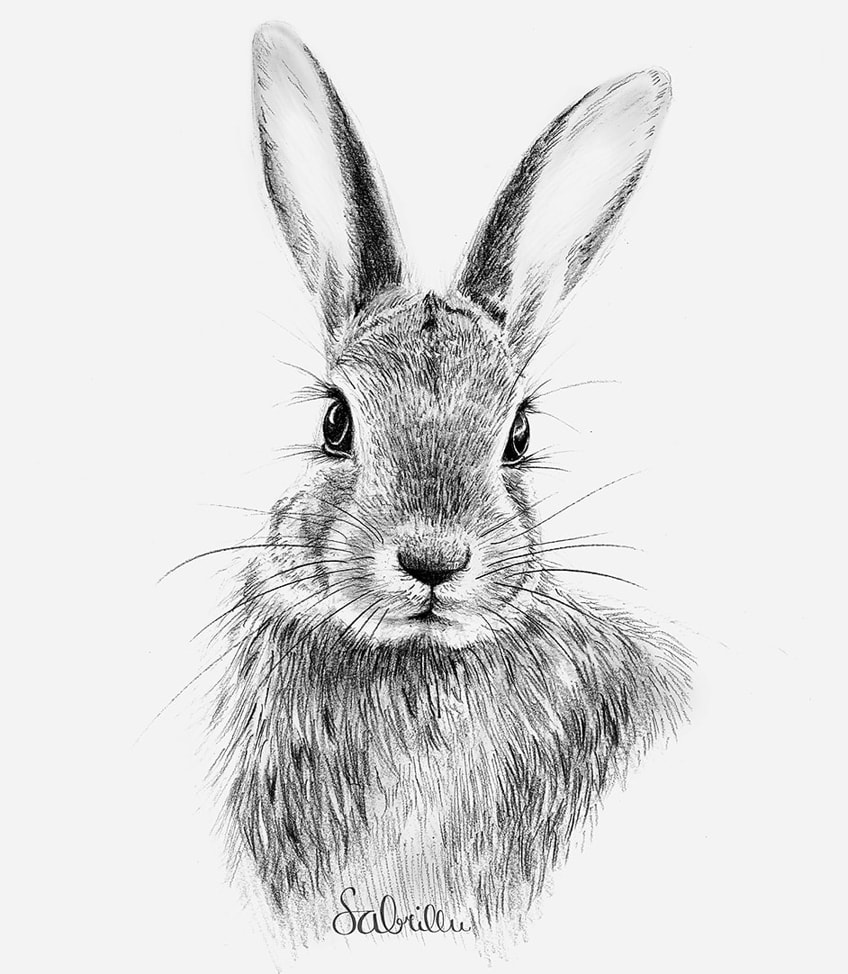Bunny Bunny Drawing Easy Step by Step
Little fluffy bunnies are some of the cutest animals you can draw. Maybe you would love to learn how to draw a bunny, but you are afraid that they are too complicated? Does the idea of drawing fur make you want to pack up your pencils and call it a day? In this wonderful guest tutorial by Sabrina Hassler, we want to show you how easy it is to draw a beautiful bunny, fur and all.
Table of Contents
- 1 How to Draw a Rabbit Step by Step: Simple Bunny Drawing Tutorial
- 1.1 Gather Your Materials Together
- 1.2 Step 1: Sketching Out Your Rabbit Drawing
- 1.3 Step 2: Fleshing Out Your Sketch
- 1.4 Step 3: Time for Some Light Shading
- 1.5 Step 4: Let Us Make That Shading Darker
- 1.6 Step 5: Transitioning Softly
- 1.7 Step 6: Adding Highlights with Your Eraser
- 1.8 Step 7: Time to Draw the fur
- 1.9 Step 8: Amping Up the Contrast
- 1.10 Step 9: Adding the Final Details
- 1.11 Step 10: Admire Your Beautiful Creation
How to Draw a Rabbit Step by Step: Simple Bunny Drawing Tutorial
With their twitching nose, long and slender ears, big round eyes, and fluffy fur, rabbits are beautiful creatures. Rabbits are typically private animals, so it is rare to see one out in nature. Although at first glance, it may seem daunting to learn how to draw a bunny, in this simple, step-by-step tutorial, we break the process down into manageable steps. Before you know it, you will be rabbit drawing with ease.
Gather Your Materials Together
Having the right tools at your disposal is the first step to creating an easy bunny drawing. If you do not have the right pencil or eraser, drawing a rabbit will be so much harder than it needs to be. We suggest you have this basic equipment:
- Good quality drawing paper should be heavy with a fine texture, like this Strathmore sketching paper.
- A set of sketching pencils – we like the ones from Faber Castell.
- A cotton swab or a blending stub if you have one.
- A good eraser like this one from Staedtler.
If you are new to sketching, you may like to have a reference photograph of the bunny you want to draw. For this tutorial, we used this photograph of a cottontail bunny by photographer Deena Sveinsson. Continue reading to find out how to draw a rabbit step by step.
Step 1: Sketching Out Your Rabbit Drawing
The first step is learning how to draw a bunny face. Although you will end up erasing much of this initial sketch, it is an essential first step in learning how to draw a rabbit. Our first tip is to use an HB or H pencil when outlining this initial sketch and to try not to press hard. You want to be able to erase these guiding lines completely.
The best way to capture the right proportions in any animal drawing is to break it down into simple shapes. When learning how to draw a bunny face, the best shapes to use are ellipses.
- Begin with a single, fairly large, and elongated ellipse in the center of your page. This first shape is the main body of your rabbit's head.
- Draw a curving cross within this main ellipse. Ideally, you want the center verticle line to bulge in the same direction that the rabbit's head is facing in your composition, and you want the horizontal line to bulge downwards. This cross helps you place the facial features on your bunny.
- For the ears, you are going to draw the next two elongated ellipses that meet in the top third of the face. It can be helpful to look at your reference photograph to help you get the right angle in the ears.
- To mark out the chubby bunny cheeks, you can draw another slightly fatter and horizontal ellipse. This ellipse should fit between the bottom of your main face shape and the horizontal cross-section.

Step 2: Fleshing Out Your Sketch
Now that you have the basic anatomic proportions of your rabbit drawing down, it is time to flesh it out. You can use the cross to add beautiful eyes, a little nose, and a fluffy chin to your simple bunny drawing.
- The eyes should sit just above the horizontal line of the cross. A bunny's eyes are more towards the side of its head, and its nose protrudes in front of them. You can easily capture this difference in depth by drawing a small line from the top of the eyes and curving down and inwards.
- Your bunny's nose should sit just above the bottom of its face. You can use the vertical line of the facial cross to place the nose correctly. It is shaped a little like a crescent moon. Rabbits' noses tend to stick out a little more right at the bottom, and you can capture this shape with two small outwardly curved lines from the base of the chin to in line with the nose.
- You will notice that the ears of your bunny in the reference photograph are not a smooth ellipse. The ears are a little more narrow at the tip, and about halfway down, they begin to widen. You can carefully alter the shape of your rabbit's ears. Finally, add in the line to differentiate between the inside and outside of the ears.
- The final step in the fleshing out process is to join the outlines of your ellipses together with a smooth line. Once you have created a fleshed-out sketch of your bunny, you can erase the construction lines.
Step 3: Time for Some Light Shading
Shading is an integral part of any sketch because it helps to create dimension and depth. The exact areas that you will shade depend entirely on the reference photograph you are using. It is best to use a 2B or HB pencil for this first round of light shading, and remember not to make things too dark just yet.
- For this first shading step, you want to locate the dark and medium shadow areas in the reference photo. In sketching, we use shading to emphasize shadow and dimension, so it can help to determine if and where the light source in your composition is.
- In our composition, we added this first round of light shading to the inner and outer edges of the rabbit's ears, with more emphasis on the inner portion. We also add a little down the bridge of the bunny's nose just over the eyes. We also added light shading on the cheeks behind the nose.
- Even in this first stage of shading, you must make sure that you shade in the right direction. You can add a lot of shape and dimension to a sketch by shading with the direction of the differently shaped components. In terms of this simple bunny drawing, make sure that your nose shading follows the shape of the nose. Another important place for you to consider the direction of your shading is on the bunny's cheeks. You want to shade outwards and downwards.
- Be careful not to get too trigger happy with this initial shading. If there are very light areas on your photograph, leave them blank on your paper.

Step 4: Let Us Make That Shading Darker
This step is pretty much what it says on the tin. Using a softer pencil from your set, preferably a 4B, you want to add to the very darkest areas of your rabbit drawing.
- At this stage, you can shade in the eyes of your rabbit. When doing this, be sure to leave the highlighted area (as on the photograph) blank.
- Softer pencils like the 4B are darker because they have more graphite than an HB pencil. While this darkness is exactly what we want at this stage, it is much harder to erase these pencil marks completely. Take it slowly when adding this darker level of shading, as you may not be able to undo it.
Step 5: Transitioning Softly
With your areas of dark shading contrasting with the blank spaces of paper, your simple bunny drawing will not be looking like a polished product yet. In this step, we are going to be gently blending the darkest areas of shading with the blank paper. You will need a blending stump or a cotton swab for this step.
- Using your blending instrument, you are simply going to wipe gently over your pencil lines. As you did with the shading, be sure to move your blending instrument in the right direction to add dimension.
- As you gently blend out your darker areas of shading, you will drag small amounts of graphite into the blank spaces. This step is essential if you want a smoother and more coherent-looking drawing. You are, of course, more than welcome to leave this step out if you like a slightly rougher finish.

Step 6: Adding Highlights with Your Eraser
The highlight is just as important as the shading when it comes to making your simple bunny drawing pop. We have the shading down, so it is time to pay attention to the highlights. For this step, we recommend using the sharp edge of an eraser or the eraser on the end of a pencil.
- Try to find the brightest areas in your bunny reference photo. In our reference photo, these highlighted areas are around the nose, on the bridge above the eyes, on the tips of the ears, and in the eyes themselves.
- During the last blending step, you may have dragged some graphite over these precise areas of highlight. You can look at the example drawing to get a better idea of where exactly you may want to erase.
- The wonderful thing about using a precise eraser is that you can create very thin, hair-like highlights. Adding highlights like this can help make your drawing more realistic.
Step 7: Time to Draw the fur
Drawing the fur may be one of the most daunting parts of this simple bunny drawing tutorial because it looks like a lot of work. In truth, you have already laid much of the groundwork for the fur, so you have nothing to worry about. For this step, you are going to need a very dark pencil – any one between a 4B and a 9B.
- Following the direction of your shading and highlights, draw lots of tiny individual hairs with your pencil. The hairs on the ears and head of your rabbit are much shorter than those on the body. Make sure that you echo this with the length of your pencil strokes. The hairs on your bunny's nose are particularly short, and you can even use dots to capture them.
- The hairs on the body of your rabbit will be a little longer and can be slightly curved. The hairs on the body can also be a little darker if you like, as this can help add some dimension to your simple rabbit drawing.
- Not all hairs grow in the same direction. Drawing the hair in the right direction, just like with the shading, can add a lot of dimension to your drawing.

Step 8: Amping Up the Contrast
Using a black coloring pencil or even a black crayon, we are going to make the dark areas even darker. This step of the simple bunny drawing tutorial increases the contrast in your drawing, making it more three-dimensional and realistic.
- The eye is automatically attracted to darker areas in an image. Adding more black to the eyes, nose, and mouth will attract the eye of your viewer.

Step 9: Adding the Final Details
Your beautiful rabbit drawing is almost complete! In this final stage, we are adding the last details that finish off your drawing, particularly whiskers and eyelashes. We recommend using a harder pencil for these final details, like an HB, because we do not want them to be very dark. Hard pencils also do not get blunt as quickly as soft pencils, so you can maintain an even stroke width.
- Your rabbit's long whisker hairs tend to be very thin and quite light, so you need to move your hands quickly. Begin each stroke by pressing firmly on your pencil, and ease off as you finish the stroke. This variation in pressure will make the whisker darker and thicker at the base and create a beautiful taper at the end.
Step 10: Admire Your Beautiful Creation
Just like that, you have created a beautiful and easy bunny drawing. We really hope you have enjoyed using this tutorial and that you are happy with your final drawing. Now that you know how to draw a rabbit, you can try drawing some other fluffy creatures. We hope that this tutorial has inspired your creativity and given you the tools to keep creating and experimenting!


Sabrina Hassler
This simple bunny drawing tutorial was given by Sabrina Hassler, an Austrian freelance illustrator. Sabrina specializes in creating beautifully detailed pencil drawings of animals and people. Following her five-year-long education at art school, Sabrina studied teaching for elementary school and music. Sabrina has been working as an artist and illustrator since 2018, and most of her clients are publishers and advertising agencies. Sabrina loves to share her knowledge and passion for art with others, and we thank her kindly for this simple but effective tutorial.
https://www.instagram.com/sabrillu_/
https://blog.sabrillu.com
hernandeznethen55.blogspot.com
Source: https://artincontext.org/how-to-draw-a-bunny-face/
0 Response to "Bunny Bunny Drawing Easy Step by Step"
Post a Comment